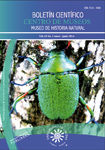Authors
Abstract
The Colombian tapir is found in the Sierra Nevada de Santa Marta; it is an endemic subspecies that presents high risk of vulnerability of local extinction, because of habitat loss and hunting. This study assessed the coverage use of the Colombian tapir in the basins of the Ancho and Palomino (Sierra Nevada de Santa Marta) rivers using telemetry and field follow-up, and analysis of vegetal coverage. It was found that the tapir tends to stay in the same patches, which are conformed by a mosaic of rainforest and secondary vegetation. On the other hand, the general action ranges for the species showed to be wide in comparison to other ranges calculated for the species with an area close to 200 ha. This kind of calculations is important to provide knowledge of the species' ecology and to establish their coverage requirements, which is important information to develop successful conservation actions.
References
ARIAS ÁLZATE, A. PALACIO, J. MUÑOZ-DURÁN, J., 2009. Nuevos registros de distribución y oferta de hábitat de la danta colombiana (Tapirus terrestris colombianus) en las tierras bajas del norte de la Cordillera Central (Colombia). Mastozoología Neotropical, en prensa, Mendoza, 2009
ARIAS ÁLZATE, A., 2008. Aportes a la Historia Natural de la Danta Colombiana (Tapirus terrestris colombianus) Compilados en el Norte de los Andes Centrales Colombianos. Tapir Conservation. The Newsletter of the IUCN/SSC Tapir Specialist Group. Vol. 17/2. No. 24. December 2008
BAASCH, D. TYRE, A. MILLSPAUGH, J. HYGNSTROM, S. VERCAUTEREN, K., 2010. An evaluation of three statistical methods used to model resource selection. USDA National Wildlife Research Center - Staff Publications. Paper 867. http://digitalcommons.unl.edu/icwdm_usdanwrc/867
CALENGE, C., 2011. Home Range Estimation in R: the adehabitatHR Package. Office national de la classe et de la faune sauvage. Saint Benoist. France
COELHO, I. OLIVEIRA, L. OLIVEIRA, M. CORDEIRO, J., 2008. The Importance of Natural Licks in Predicting Lowland Tapir (Tapirus terrestris, Linnaeus 1758) Occurrence in the Brazilian Pantanal. Tapir Conservation. The Newsletter of the IUCN/SSC Tapir Specialist Group. Vol. 17/2. No. 24. December 2008
DASGUPTA, N. & ALLDREDGE, R., 2000. A Chi-Square Goodness-of-Fit Analysis of Dependent Resource Selection Data. Biometrics, Vol. 56, No. 2 (Jun., 2000), pp. 402-408
FAHRIG, L., 2003. Effects of habitat fragmentation on biodiversity. Annu. Rev. Ecol. Evol. Syst. 2003. 34:487–515
FLORA & FAUNA CHILE LTDA., 2012. Diagnóstico del estado poblacional del puma (Puma concolor) y evaluación de la efectividad de medidas de prevención de ataques a ganado doméstico en la Provincia de Cautín, en la Región de la Araucanía. Disponible en: www.bcn.cl/obtienearchivo%3Fid%3Ddocumentos/10221.1/37487/1/Informe%2520Pumas%2520de%2520la%2520Araucania%2520FINAL.pdf+&cd=1&hl=es&ct=clnk&gl=co. Providencia, Santiago
FLOREZ, F. K., 2008. Distribución histórica y actual de la población de danta de tierras bajas Tapirus terrestris colombianus (Hershkovitz 1954) más al norte de Sur América. Nativa.org. Colombia. Tapir Conservation. The Newsletter of the IUCN/SSC Tapir Specialist Group. Vol. 17/2 n No. 24. December 2008.
FUNDACIÓN PROSIERRA NEVADA DE SANTA MARTA., 2010. Cobertura vegetal escala 1:100.000
GASCON, C. WILLIAMSON, B. DA FONSECA, G., 2000. Receding Forest Edges and Vanishing Reserves. Science 26 May 2000: Vol. 288 no. 5470 pp. 1356-1358.
HERSHKOVITZ, P., 1954. Mammals of Northern Colombia, preliminary report no. 7: Tapirs (genus Tapirus), with a systematic review of American species. Proceedings of the United States National Museum. Smithsonian Institution. U. S. National Museum. Vol. 103. No. 3329Washington, 1954.
KAUHALA, K. & AUTTILA, M., 2010. Estimating habitat selection of badgers - a test between different methods. Folia Zool. – 59(1): 16 – 25 (2010)
MANLY, B. MCDONALD, L. THOMAS, D. MCDONALD, T. ERICKSON, W., 2002. Resource Selection by Animals. Statistical Design and Analysis for Field Studies. Second Edition. Springer.
MONTENEGRO, O., 2009. La conservación biológica y su perspectiva evolutiva. Acta biol. Colomb., Vol. 14 S, 2009 255 – 268
MONTENEGRO, O., 2005. Programa Nacional para la Conservación del Género Tapirus en Colombia. Ministerio de Ambiente, Vivienda y Desarrollo Territorial - Instituto de Ciencias Naturales, Universidad Nacional de Colombia. Colombia.
MONTENEGRO, O., 1998. The behavior of lowland tapir (Tapirus terrestris) at a natural mineral lick dl the Peruvian Amazon. A thesis presented to the graduate school of The University of Florida in partial fulfillment of the requirements of the degree of Master of Science. University of Florida.
MORRISON, M. MARCOT, B. MANNAN, W., 2006. Wildlife–Habitat Relationships. Concepts and Applications. Third Edition. Island Press, Washington, DC.
NEU, C. BYERS, R. PEEK, J., 1974. A Technique for Analysis of Utilization-Availability Data. The Journal of Wildlife Management, Vol. 38, No. 3. (Jul., 1974), pp. 541-545.
OJASTI, J. & DALLMEIER, F (editor)., 2000. Manejo de Fauna Silvestre Neotropical. SI/MAB. Series No. 5. Smithsonian Institution/MAB Biodiversity Program, Washington D.C.
PADILLA, M. & DOWLER, R., 1994. Tapirus terrestris. The American Society of Mammalogists. Mammalian Species. No. 481, pp. 1-8, 3 figs.
RICHARD, E. & JULIÁ, J., 2000. El tapir (Tapirus terrestris): dieta y manejo en un bosque secundario de la ecoregión de selvas pedemontanas. Estatus en Argentina. En: Cabrera E., C. Mercolli y R. Resquin (Eds). Manejo de Fauna Silvestre en Amazonia y Latinoamérica. CITES Paraguay, Fundación Moisés Bertoni y University of Florida. 578 p. Paraguay
RICHARD, E. & JULIÁ, J., 2000. (b) Aspectos generales de la biología, estatus, uso y manejo del Tapir (Tapirus terrestris) en Argentina. Curso taller teórico práctico de capacitación de docentes auxiliares de la reserva experimental Horco Molle. REHM, serie apuntes No. 1. Versión 2.1. Universidad Nacional de Tucumán. Facultad de Ciencias Naturales e Instituto Miguel Lillo.
RODGERS, A. & KIE, J., 2007. HRT: Home Range Tools for ArcGIS®. User’s Manual. Centre for Northern Forest Ecosystem Research. Ontario Ministry of Natural Resources.
TOBLER, M. CARRILLO-PERCASTEGUI, S. POWELL, G., 2009. Habitat use, activity patterns and use of mineral licks by five species of ungulate in south-eastern Peru. Journal of Tropical Ecology (2009) 25:261–270

 PDF (Español)
PDF (Español)
 FLIP
FLIP


















